
by fmadmin | Jul 4, 2023 | Content
ChatGPT is an amazing tool if used correctly
ChatGPT is everywhere we turn. Schools, universities, workplaces, your neighbour, are freaking out about what its rapid progress will mean.
It can be an amazing tool for providing and summarising information, but the reader shouldn’t be able to identify it in your writing. Knowing its limitations is key to making sure you know how to use it and produce the best result.
And, if you’re anything like me, conversations about ChatGPT progress almost as fast as the uptake of its platform in December 2022. Dinner table discussions swerve from ‘are you using ChatGPT’ to ‘will ChatGPT take your job, too?’ to ‘Do you think human-humans and AI-infused-superhumans can cohabitate?’
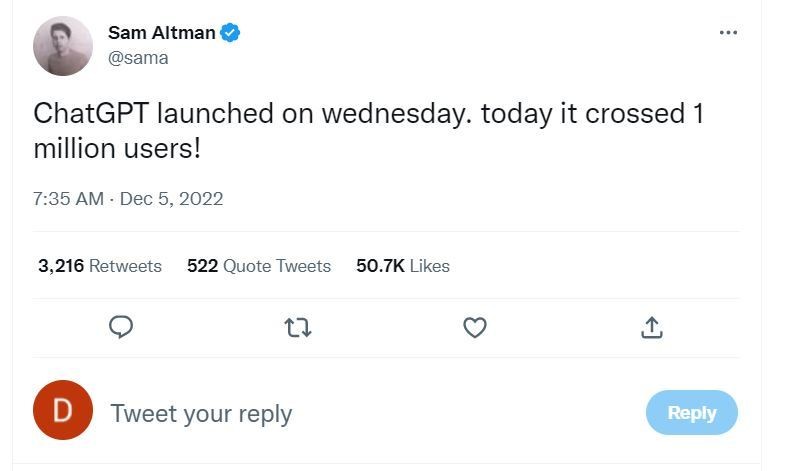
Sam Altman, OpenAI’s chief, said on Twitter that ChatGPT had more than one million users in the first five days after it launched.
When it comes to writing copy, ChatGPT has its limitations, but most of the sub-par output we’re seeing is due to not understanding how to best use it.
So, while we’re still deciding how to feel about the seemingly unavoidable adaptation of ChatGPT, we can at least use it properly!
Which means understanding what it is and what it can do, and what it cannot do (very well, yet).
Don’t take things out of context, people!
‘Everyone is a genius. But if you judge a fish by its ability to climb a tree, it will live its whole life believing that it is stupid.’ – Albert Einstein (allegedly)
Below we’ve compiled a list of 6 common mistakes, and tips on how ChatGPT can help you write copy – effectively!
Mistake #1: Not understanding ChatGPT’s strengths and capabilities
Outcome: Your writing is too generic and reads as a summary.
ChatGPT is a language model that can answer questions and assist you with tasks such as composing emails, essays, and code, but people are using it to write poems, and even to have philosophical conversations and debates…
Remember that ChatGPT can’t talk about anything after 2021, tell the future, discuss political issues, always be accurate, give references, or provide thought-leadership. It also can’t be confidential.
Tip: Provide direction and use ChatGPT to gather information.
Mistake #2: Not being specific about what you want
Outcome: Responses that are not fit for purpose.
When making requests, be as specific as possible to ensure that the request is clear and can be fulfilled. The more specific you are, the better understood your response will be. ChatGPT can work with general or open-ended questions, but responses won’t be as tailored.
Tip: Start with an action word and include your desired response length.
Mistake #3: Not starting a new ChatGPT session
Outcome: Your answers become convoluted and lack relevance.
ChatGPT continues its context downstream. For contextual separation, start a new topic in a new chat. This ensures you provide a fresh context so the AI can better understand and respond to the topic without any confusion or mixing of information from previous discussions.
Tip: Start a new session for each topic.
Mistake #4: Not fact-checking
Outcome: Your writing is misleading or makes false claims.
ChatGPT has a knack for writing responses that are incorrect but plausible-sounding.
Cross-reference your sources through official websites, academic papers, established news outlets, or expert opinions. Maintain a healthy dose of skepticism while fact-checking your AI’s writing and look out for inconsistencies, biases, or misleading statements.
Tip: Websites like Snopes or FactCheck.org can help verify the validity of specific claims.
Mistake #5: Not iterating responses
Outcome: ChatGPT outputs generic, purposeless responses.
Iteration helps you correct errors and adapt responses. It also helps ChatGPT as part of its learning process, so the machine can learn from mistakes, identify patterns, and enhance its understanding. Continuous learning helps improve its knowledge base.
Tip: Refine answers until you’re happy with them.
Mistake #6: Not being polite
Outcome: You get frustrated at ChatGPT after using it incorrectly.
And finally, my favourite tip! Be polite to AI. In March, ChatGPT had a verbal IQ of 155, which is superior to 99.9% of test takers. With great knowledge comes great power.
While AI models like ChatGPT are not understood as sentient beings, they are designed to engage in conversation. Being polite demonstrates kindness and consideration for each interaction, which creates a foundation for ethical guidelines and norms in human-AI exchanges. Model polite behaviour to invest in our future standard of respectful and responsible tech.
Tip: Be clear and specific, patient, and accept limitations. Provide feedback, understand how to use AI and ensure your expectations are realistic.
Looking for help with creating effective content? At Focused Marketing we have a team of multi-disciplined writers and creative professionals to help with your next project or business venture. Contact us today to make it happen!
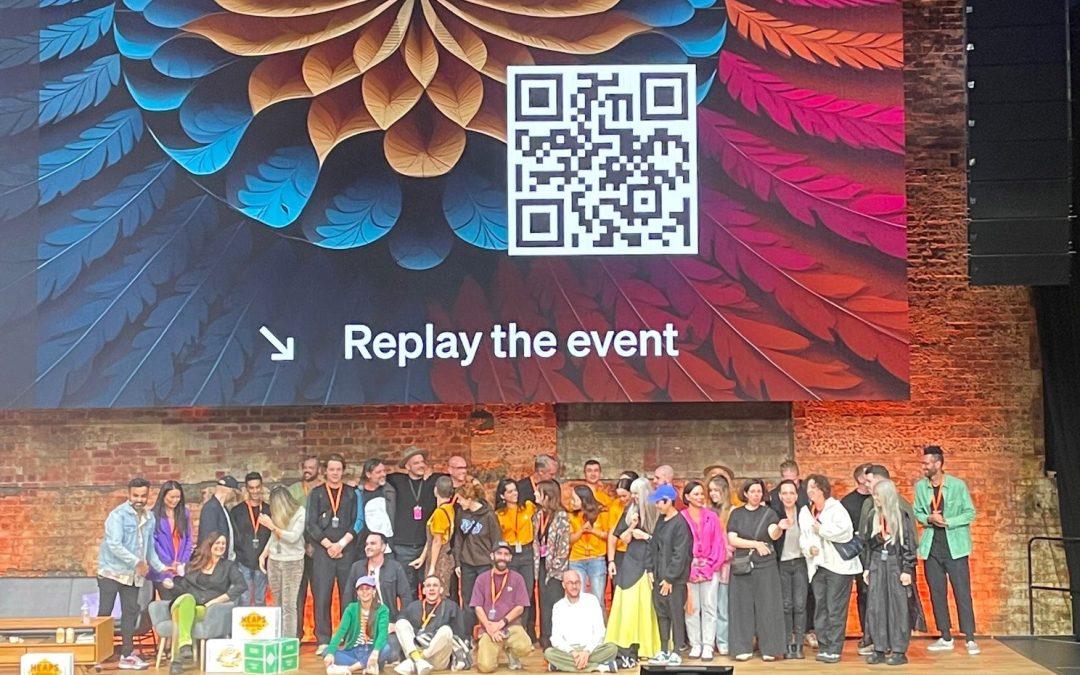
by fmadmin | Jun 20, 2023 | Digital, Strategy
We share the most impactful design themes featured at The Design Conference 2023 in Brisbane, Australia
After attending The Design Conference this month for the second consecutive year, I’m excited to share my experience and key takeaways from this amazing event.
This three-day event (7-9 June) at Brisbane’s iconic Powerhouse seeks to unite and inspire our creative and business communities, with keynote presentations, firesides and insightful discussion panels featuring a lineup of national and international guests at the top of their game.
Each year is a transformative experience where I’ve walked away feeling invigorated with a renewed sense of purpose and passion for what I do. So I thought I would share it with you!
“Be bold. Let the transformation begin.” – The Design Conference

1. Never stop playing.
This theme serves as a reminder to embrace our sense of play, child-like wonder and curiosity as creators, professionals, and businesses alike. To continue asking “what if?”, to continue experimenting, and not let the fear of making mistakes hold you back.
Wonderful Brisbane-based creatives Ellen Powell (Founder of The Somewhere Co), designer and artist Rachel Burke, and potter Bonnie Hislop demonstrated their unique sense of colour, playfulness and whimsical aesthetic that injects a ton of fun into the everyday. From The Somewhere Co’s vibrant patterned lunch satchels to Rachel Burke’s fabulously kitsch tinsel coats, to Bonnie Hislop’s vases adorned with rainbows, glitter and tongue-in-cheek catchphrases, their pieces inspire boundless joy.
The power of play, imagination and exploration has also driven the success of many agencies including Beetroot, based in Thessaloniki, Greece. Keynote speaker Alexis Nikou, co-founder of Beetroot, demonstrated that we should never underestimate the power of self-initiated projects. Their constant doodling and scribbling have not only contributed to many client projects, but also led to them creating a multi-disciplinary art exhibition called “The Greek Monsters”. The series playfully reimagines the classic monsters of Greek mythology to symbolise the poor representation of modern Greece in the media at the time. The exhibition gained widespread popularity, eventually touring internationally and raising the agency’s profile.
Play increases engagement, creativity and innovation which can have an amazing impact on your design, project or business.
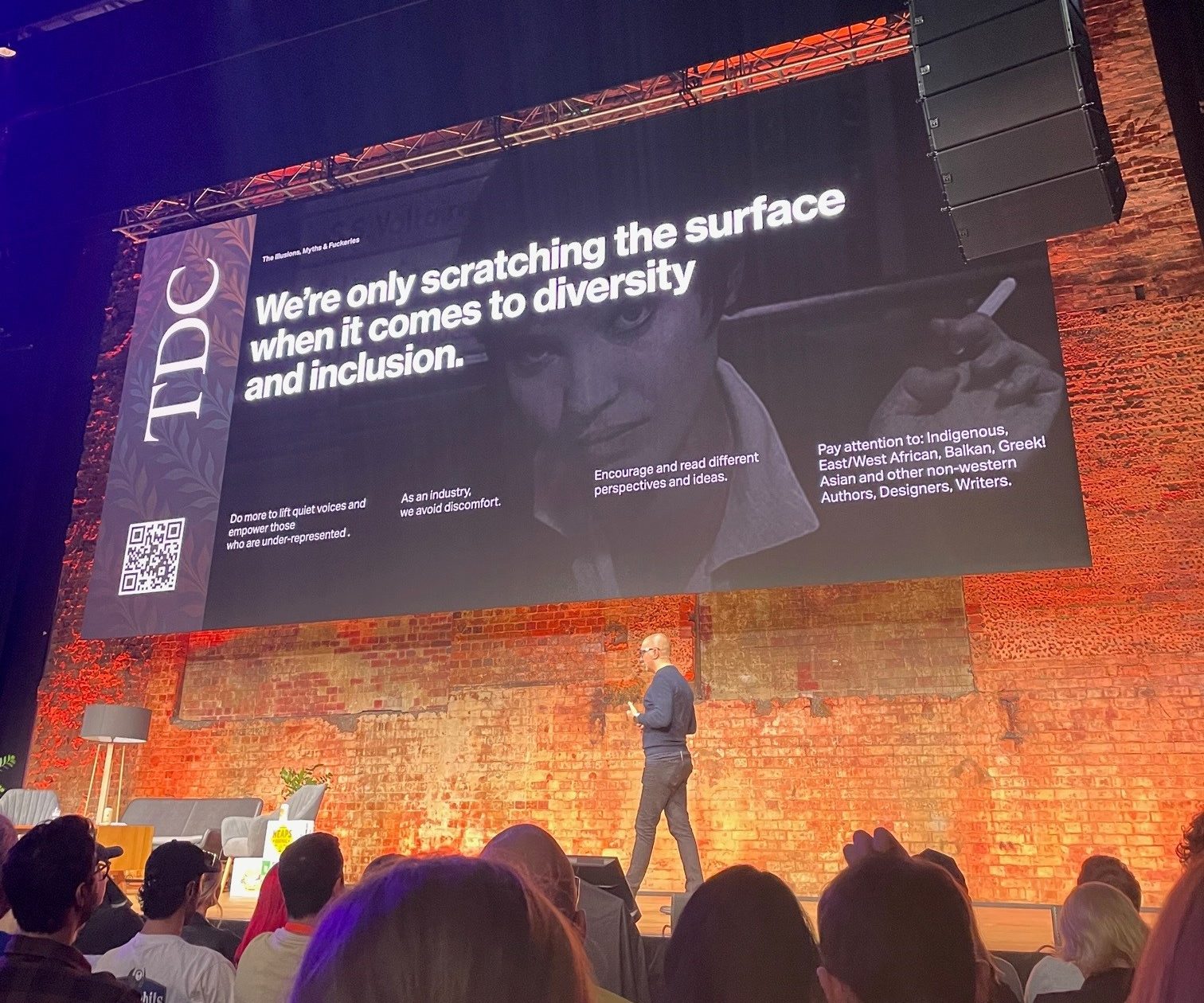
2. Celebrate and amplify diverse voices.
Throughout the conference, we were encouraged to embrace our differences and celebrate them in others. Our unique backgrounds, ethnicities, cultures, ages, and diverse identities of all kinds, when tapped into collaboratively, are truly powerful.
“We’re only scratching the surface when it comes to diversity and inclusion.” – Dimitri Antonopoulos
The Design Conference continues to spotlight an incredibly diverse range of creatives, both geographically and elsewise. This year’s conference, for example, hosted keynote speakers ranging from Greece to Argentina, Singapore to South Africa, the Netherlands to New Zealand.
Many presenters relayed their personal stories of the challenges they faced throughout their childhood or in their professional life, feeling the pressure to assimilate and the stifling of their unique identities. When the barriers placed on them were lifted and their authentic self was allowed to shine through, this translated to all aspects of their life.
Encouraging and reading different perspectives, and amplifying marginalised voices will enhance your overall perspective and strengthen the outcome of your design, project, or business.
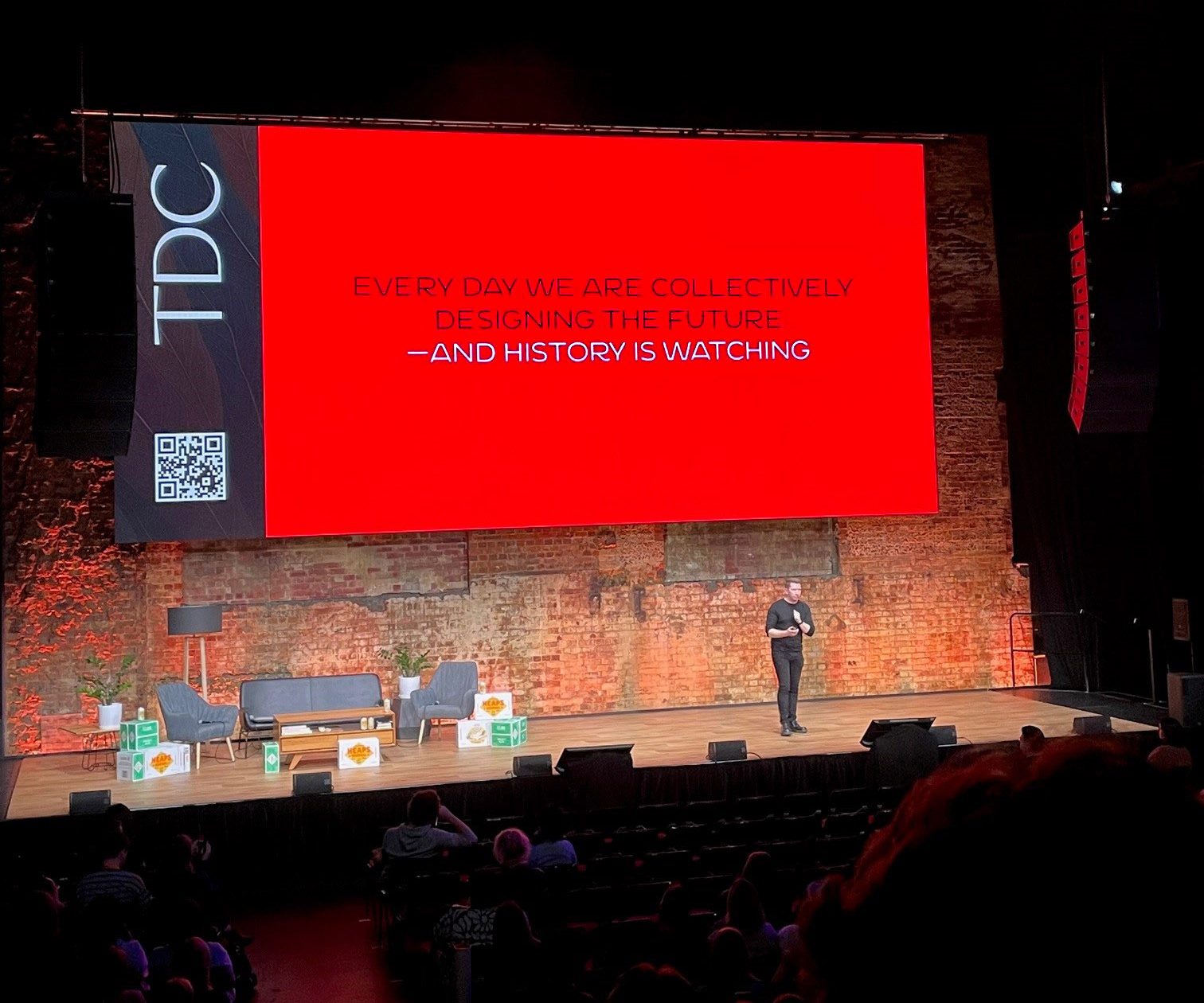
3. Create meaningful design.
“Empathy and understanding is the essential ingredient for good design.” – Meg Perkins
As designers, we must aspire to create meaningful design that goes beyond aesthetics, with the hope of shaping and benefiting the world around us.
In the grips of constant change and technological evolution (and yes, obviously artificial intelligence), the future of design may seem uncertain. We are seeing a shift towards what’s truly important to us as humans – as creators, entrepreneurs, and consumers.
Businesses face mounting pressure to prioritise ethics, environmental sustainability, and social impact, while audiences increasingly seek alignment with brands that share their values.
As Kevin Finn, founder of TheSumOf, spoke about in his fireside session, this means purpose-led brands with impact are forging the way forward. So, be intentional with every decision you make and consider the kind of future you want to work towards.
The Design Conference once again served as a catalyst for personal and collective growth. We are reminded of the impact that design can have – to instil meaning, drive change, shape behaviours and create positive impact for brands and businesses. Thanks to organiser Matt Haynes, the keynote speakers, and everyone involved for another spectacular year!
Looking for help with design? At Focused Marketing we have a team of multi-disciplined designers and creative professionals ready to assist you with your next design, project, or business venture. Contact us today to make it happen!

by fmadmin | May 31, 2023 | Content, Strategy
Do you have a marketing budget and is it currently working for you?
Are you finding it hard to project what you’ll need in the year ahead, or wondering what should sit within your marketing budget? We offer practical steps to forecast your best marketing budget yet.
A new financial year will soon be upon us and many companies, especially those without marketing departments, still fail to budget for marketing.
Too often, business owners regard marketing as an optional cost centre – especially when economic times are tough! However, it is important to realise that marketing is an investment, and not a cost to your business.
“Because the purpose of business is to create a customer, the business enterprise has two – and only two – basic functions: marketing and innovation. Marketing and innovation produce results; all the rest are costs. Marketing is the distinguishing, unique function of the business.” – Peter Drucker
Digital marketing makes it easier for B2B companies to be found, remembered, and make an impression. This increases competition but also opportunity – now is the time to ensure your investment is working for you!
Step 1: Identify what should fall under your marketing budget
Let’s go back to basics, don’t forget the marketing P’s. Many companies now treat marketing solely as communications. The activities listed below make up your marketing mix and should be considered when planning your marketing budget.
- Product – what do you sell? Is it services, consulting, or physical goods? A key part of your marketing mix is product improvement.
- Price – how much do you charge? And how is it impacting the way customers see your brand? Improve your competitive position by researching and reviewing your pricing strategy.
- Place – where do you promote your product or service? Does your company attend industry seminars and events? Does the brand have a physical and digital presence?
- Promotion – what strategies do you use to help customers find out about you? Do you invest in business development, a referral strategy, or content and digital marketing?
- People – Who are you targeting and directly and indirectly engaging with? What challenges are you solving for them? Are they high value?
- Process – How will you deliver the product to them? Consider your customer journey and experience. What marketing tools and platforms do you currently use?
- Physical evidence – How are your products and services packaged? Consider your brand identity. Is it consistent and well presented across all platforms? Do you look professional and capable?
Step 2: Analyse your marketing budget and activities from the last financial year
Now that you have identified what should fall within your marketing budget, it’s time to have a good hard look at what you invested in across your business over the last 12 months. Analysing your data, feedback, and results will help you to establish your marketing return on investment (ROI). It is a great way to determine if you should continue investing in existing marketing activities, leave them behind or try something else. We have identified some key questions to think about below:
- Is it a functional requirement for your business to market itself effectively? E.g., Branded uniform, software, signage.
- How successful was each investment in engaging your audience? E.g., New enquiries, email open rates, social likes, comments.
- How successful was each investment in driving new customers to your business? E.g. quotes sent, sales, referrals.
- How successful was each investment in creating a positive customer experience that will likely encourage them to refer others? E.g. Reviews, feedback, customer satisfaction surveys.
- How successful was each investment in providing brand awareness and exposure? E.g. Channel traffic, new subscribers.
Step 3: Reset and establish a new overall marketing budget for FY23/24
Hopefully by now you’ve got an idea of what’s been working and what hasn’t. Maybe you’ve also got some new ideas to add into the mix. That’s great!
Now that you have a thorough understanding of your previous marketing budget and a breakdown of budget categories, it’s time to forecast for the next financial year.
- Consider the marketing P’s.
- Set a ballpark budget for overall marketing spend e.g. % of total business revenue – consider the 5% revenue rule.
- Identify and analyse any marketing opportunities, campaigns or ideas to determine if they support your wider business objectives, forecast costs and prioritise.
- Collaborate with your stakeholders to ensure their requirements are captured.
- Be realistic of how much you have and what you can achieve.
- Ensure reporting and monitoring measures are in place to determine ROI.
Step 4: Get help – implement or outsource?
There’s no singular answer to the age-old question: in-house or outsourced? Other than – it depends! But setting a marketing budget will ensure you most effectively delegate tasks and resources. And will ensure you can answer this question:
Who is responsible for your marketing activities, and are they the most effective resource?
We have seen sales co-ordinators dabble with “fun” projects such as creating flyers or branded content for social media. This may take days to achieve a rough version of something an agency can deliver with professional polish in a matter of hours. Budgeting for professional help to execute projects keeps in-house resources focused on their job at hand.
Remember, marketing is an investment that should support your overall business objectives, and with careful planning and evaluation, you can make the most of your marketing budget.
Focused Marketing would love to support your marketing planning and budgeting for the next financial year. Book us in for a free Coffee Consult to start a conversation. Our structure at Focused Marketing is designed to deliver the benefits of a full-service marketing agency for less than you would pay for an in-house marketing manager.
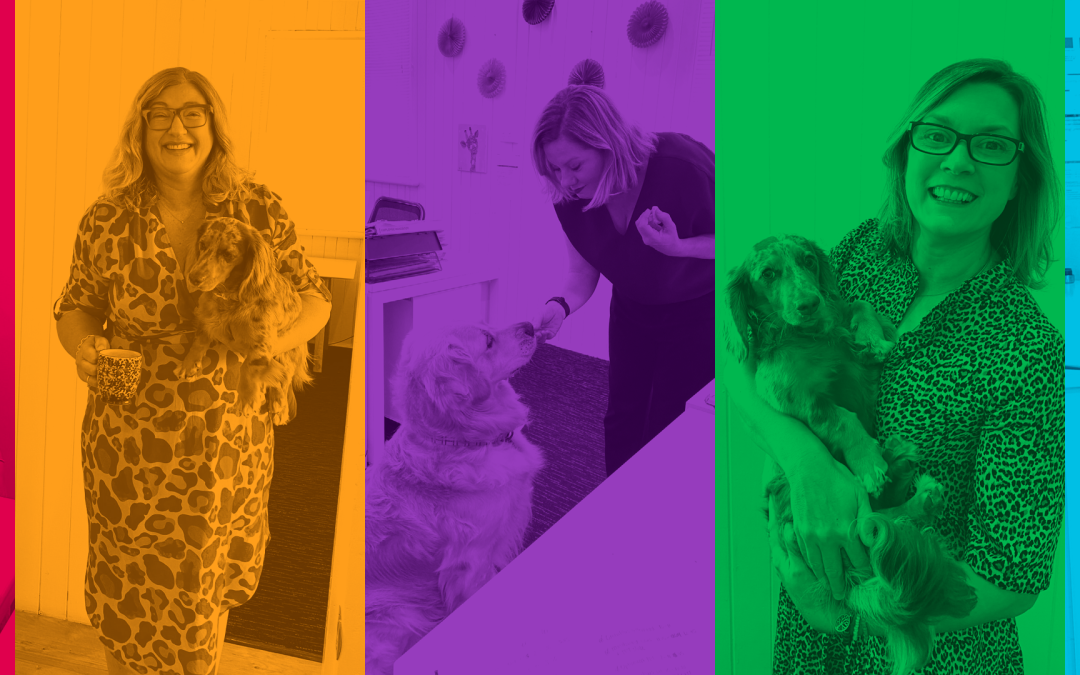
by fmadmin | May 4, 2023 | Content, Strategy
Create a pet inclusive workplace: Our 5 benefits of having dogs in the office
Did you know … More than two-thirds of Australian households now own a pet, with dogs accounting for 48% of these.
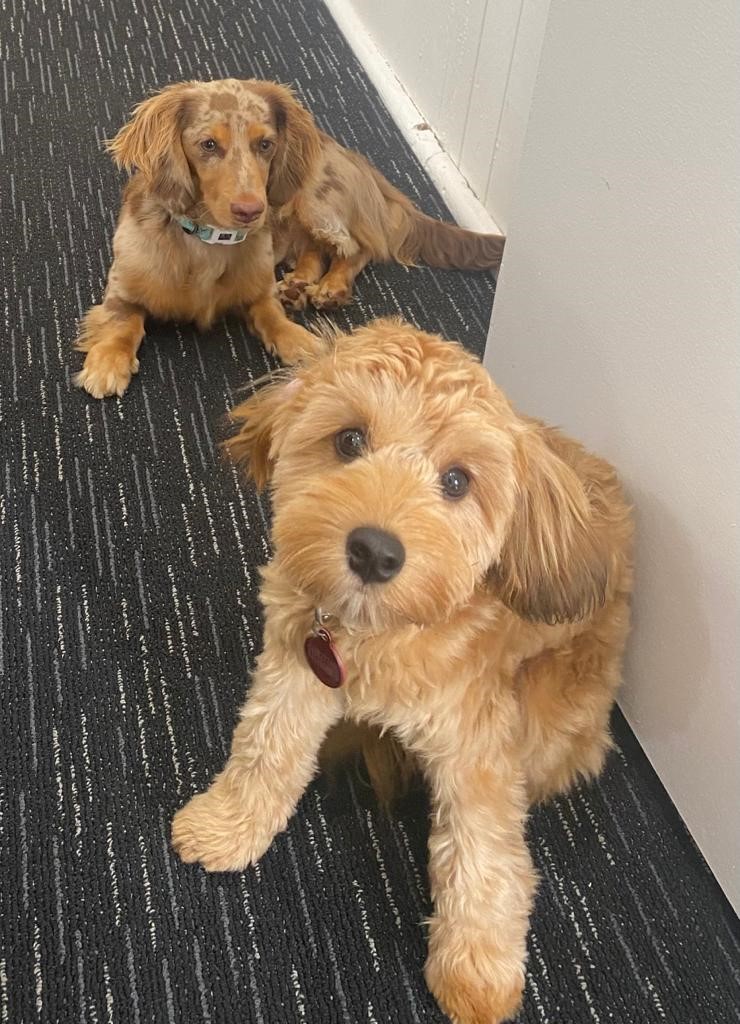 The benefits of owning a pet are well known. But do these benefits transfer across to the workplace?
The benefits of owning a pet are well known. But do these benefits transfer across to the workplace?
On my first day at Focused Marketing, I must admit, I was feeling a bit nervous walking up the stairs. But to my surprise – as I opened the front door, I was greeted by not just one, but TWO adorable fur babies! Winnie, our CEO Kerri’s dachshund, and Dusty, our Marketing Director Caitlin’s Cavoodle, were there to welcome me. And let me say, as a proud pet parent of my own Golden Retriever, Barney, it was an instant connection! I felt a huge wave of relief wash over me. It was such a warm and wonderful welcome to the team.
“I started working at Canva seven years ago, I used to bring my dog in every day. It just felt very natural and added a sense of connection.” Chris Low, the head of Vibe (Canva)
Check out some other pet-friendly Australian companies.
Here at Focused Marketing, we encourage our team to bring their furry friends into the office on a regular basis and have seen amazing benefits in doing so. Even our clients enjoy a cuddle!
 Here are 5 benefits of having dogs in the office that we have personally experienced as a team.
Here are 5 benefits of having dogs in the office that we have personally experienced as a team.
1. Reduce feelings of stress.
Having your dog by your side can reduce feelings of stress especially when faced with a difficult project or deadline. By playing with and petting your pup, you can increase your levels of oxytocin, a stress-reducing hormone, helping you feel more at ease.
2. Improved overall mental wellbeing.
Another huge perk of bringing your pup to work is the overall positive effects on your mental wellbeing. Not only does having a dog in the office promote a sense of connection and foster more social interaction amongst your team, but it can also lead to a boost in your mood and increase in happiness.
3. Pet-powered performance.
Did you know that having dogs in the office can improve collaboration, productivity, and performance? Regular cuddles, playtime and walks outside encourages you and your team to take much needed breaks throughout the day. This will have a positive effect on your team’s overall performance.
4. Attractive place to work.
Creating a pet-friendly workplace can be a huge selling point when it comes to attracting new talent! By promoting a pet-friendly work culture, you can differentiate your company from others and stand out when it comes to recruitment, internal communication, and employee retention strategies.
 5. Paw-sitive work culture.
5. Paw-sitive work culture.
By boosting morale, inclusivity and encouraging social interaction amongst your team members, having dogs into your office can be a simple but effective way to promote a happier and more positive work environment and culture.
Ultimately, bringing your pet to work with depend on your workplace, OH&S policies and procedures, and culture. And having dogs in the office will require some rules and puppy etiquette. But with all things considered, it is such a wonderful experience to share with your team. So, get those tails wagging!
Bark if you need assistance with your communications strategy and our team will be happy to Make It Happen! Contact us today.

by fmadmin | Apr 3, 2023 | Content, Digital, Strategy
Increase organic traffic to your website through search engine optimisation
Did you know… 68% of online experiences begin with a search engine (BrightEdge)
So, search engine optimisation is important then, right?
The challenge is that most businesses struggle to implement effective SEO strategies. This contributes to their websites ranking low in search results… and sometimes not at all.
Think of your website as an island, metaphorically speaking.
A beautifully designed and constructed virtual destination for your guests to discover. The only problem is they can’t find you on the map! Unless you provide a way for viewers to easily find you and want to travel to your website, there is no point spending time and resources renovating it.
So, how can you improve your organic website traffic through SEO?
Shhhh… below are some insider tips from our Focused Marketing specialists, but first…
“Content is the reason search began in the first place.” – Lee Odden
What is search engine optimisation (SEO) and how does it work?
SEO, or search engine optimisation, is the practice of optimising a website to increase search engine visibility. This in turn, generates more organic traffic and hopefully, dollars for your business. But not all SEO is the same.
Here are three types of search engine optimisation worth knowing about:
1. Technical SEO
This involves optimising the website code and structure to ensure it is easy for search engine crawlers to read and index. Consider your overall website speed, mobile responsiveness, schema markup and meta tags.
2. On-page SEO
This focuses on optimising individual pages on the website, including the content and HTML source code. This includes elements such as optimising headlines, formatting content, and ensuring that keyword usage is appropriate.
3. Off-page SEO
This refers to the activities that occur outside of your website that influence its ranking on search engine results pages. Look at link building, your social media marketing, and other activities that increase the website’s authority and reputation.
So why is SEO Important?
SEO is very important. Here are some key reasons SEO may assist you and your business:
Increased Website Traffic
SEO helps to increase the visibility of a website on search engines like Google, Yahoo, and Bing. Higher visibility leads to more traffic to the website, which can lead to more sales and revenue.
Cost-effective Marketing
Unlike other marketing methods, SEO is cost-effective and offers long-term benefits. Through ongoing search engine optimisation, your website could rank highly on search engines for years to come.
Improved User Experience
SEO also improves the user experience by making the website faster, easier to navigate, and more mobile-friendly. A well-optimised website will also have relevant and high-quality content that engages users.
Competitive Advantage
By optimising your website, you can gain a competitive advantage over your competitors by appearing higher in search engine results pages.
Builds Trust and Credibility
Being on the first page of search results builds trust and credibility with users, making them more likely to engage with your website and its content.
Okay, so you now know what SEO is and why it is important. Here are our tips on what to focus on and how to get started.
Our top 8 tips for Search Engine Optimisation (SEO)
1. Understand your target audience
Understanding your target audience is key as it enables you to identify their specific needs and interests. By tailoring your keywords and content to address these areas, you can ensure your website is relevant and engaging.
2. Identify target keywords
Conduct keyword research to identify keywords and phrases that are relevant to your business and likely to be searched by your target audience. Leverage tools like Google Keywords Planner to assist you.
3. Create meaningful, keyword rich-content
As Lee Odden eloquently stated, “Content is the reason search began in the first place.” Creating relevant and timely content that is engaging and addresses your target audience and keyword search terms is exactly the point. Be sure to include your keywords throughout but don’t overdo it!
4. Optimise every element of your website
Feature your target keywords in meta titles, meta descriptions, image file names and header tags throughout your website. Assign a main keyword phrase for each individual page on your site.
5. Monitor your website performance
Improve your performance including website speed and mobile responsiveness across all devices. Optimise your images and video by compressing them and saving them in the appropriate web-friendly file types.
6. Build high-quality links
Build back-links from high-quality websites that are relevant to your business. Link your site content to relevant external websites that add value to your user e.g. provide additional information on a topic. Don’t forget to include internal links to other pages or blog articles within your own website. Leverage social media.
7. Create a Google Business account
Create, verify, and optimise your Google Business Account to improve your local SEO and capture reviews. This account will also give you access to other handy Google products including Google Trends and Google Adwords.
8. Monitor and track your SEO results
Use tools like Google Analytics to track visitors, click-through rates, and other metrics. This will help you identify key areas for improvement.
Ultimately, SEO is a great way to get more traffic to your website, but it does take some time to start seeing results.
It’s a long-term strategy that’s not going to give you an instant boost but is worth the effort if you want to get high-quality organic traffic.
So, just remember to be patient and put in a little effort, and you’ll start to see those positive results before you know it.
Looking for more information and assistance with your SEO Strategy? Contact us today and our team will be happy to Make It Happen!









 The benefits of owning a pet are well known. But do these benefits transfer across to the workplace?
The benefits of owning a pet are well known. But do these benefits transfer across to the workplace? Here are 5 benefits of having dogs in the office that we have personally experienced as a team.
Here are 5 benefits of having dogs in the office that we have personally experienced as a team. 5. Paw-sitive work culture.
5. Paw-sitive work culture.